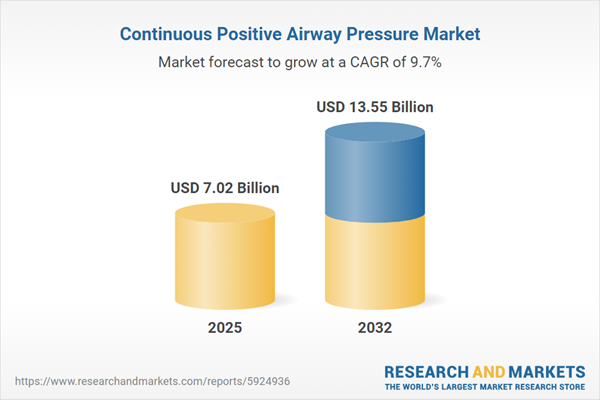Speak directly to the analyst to clarify any post sales queries you may have.
The continuous positive airway pressure (CPAP) market is experiencing considerable evolution, shaped by rapid technological integration and progressing respiratory care standards. For senior executives in healthcare, comprehending these changing dynamics is essential for informed strategy execution and leadership within increasingly complex global markets.
Market Snapshot: CPAP Market Growth and Outlook
The global CPAP market is projected to grow from USD 6.45 billion in 2024 to USD 7.02 billion in 2025, reaching an estimated USD 13.55 billion by 2032, representing a compound annual growth rate (CAGR) of 9.71%. Growth is being propelled by heightened awareness of sleep-disordered breathing, increasing acceptance of long-term respiratory therapy, and a robust pipeline of digital health solutions. Ongoing advancements in device performance and regulatory shifts compel market participants to accelerate adaptation, foster innovation, and address intensified sector competition.
Scope & Segmentation: Comprehensive CPAP Market Landscape
- Product Types: Includes core CPAP machines alongside indispensable accessories such as masks, humidifiers, filters, nasal pillows, and tubing. Emphasis on ergonomic design and expanded customization supports therapy adherence in both clinical and home-based environments.
- Modes: Encompasses Adaptive Servo Ventilation, Auto Adjusting options, Bi-Level systems, and Fixed Pressure platforms, ensuring flexibility for patient-specific respiratory disorders.
- Age Groups: Spans adults, geriatric, and pediatric users. Prioritizing device adaptability and user-centric interface enables effective implementation across all age segments and care settings.
- End-Users: Involves hospitals, clinics, ambulatory surgical centers, home care providers, and sleep laboratories. These diverse stakeholders influence the evolution of device features and overall user experience.
- Distribution Channels: Leverages established medical supply chains and innovative digital procurement platforms, improving market access for healthcare organizations and advancing international delivery efficiency.
- Applications: Addresses obstructive sleep apnea, pulmonary edema, and chronic obstructive pulmonary disease, enabling acute interventions and long-term patient management.
- Geography: Spans North America, Europe, the Middle East & Africa, and Asia-Pacific. Regional market customization is vital to meet local regulatory requirements and healthcare priorities.
- Company Coverage: Highlights prominent manufacturers including ResMed Inc., Royal Philips, Fisher & Paykel Healthcare Corporation, and BMC Medical Co., Ltd., each playing a significant role in driving industry standards and technological progress.
Key Takeaways: Strategic Insights for Senior Decision-Makers
- Integration of digital health solutions and telemedicine is expanding CPAP therapy access and streamlining care management in both clinical and home-use environments.
- Advancements in ergonomic mask designs and complex device algorithms are enabling individualized respiratory therapy, fostering improved patient adherence and clinical outcomes.
- Focus on regional sourcing and adaptive manufacturing models reinforces supply chain continuity and helps limit potential disruptions from international sourcing variabilities.
- Pediatric and geriatric innovations address the growing demand for age-appropriate therapeutic options, ensuring broader applicability and patient-centric care.
- Collaboration among device manufacturers, technology providers, and logistics firms is facilitating the entry into emerging healthcare markets and supporting wider international market expansion.
Tariff Impact: U.S. Policy Changes and Global Supply Chains
Recent U.S. tariff adjustments on CPAP components prompt manufacturers to reassess sourcing strategies and production footprints. This environment promotes development of domestic partnerships, increased regional manufacturing, and improved supply chain agility, all contributing to regulatory compliance and cost efficiency across both domestic and international markets.
Methodology & Data Sources
This CPAP market analysis is based on interviews with industry experts, critical review of company and sector data, and direct input from supply chain stakeholders. Third-party validation processes ensure the information is reliable, independently reviewed, and actionable for leadership teams.
Why This Report Matters: Supporting Informed Leadership
- Senior executives receive a full overview of CPAP technology trends in conjunction with evolving regulatory frameworks, empowering data-driven planning and performance benchmarking in respiratory care networks.
- Organizations can refine compliance procedures, reimbursement management, and distribution pathways, embedding resilience across increasingly multifaceted healthcare logistics channels.
- Decision-makers are well-equipped to identify new trends and refine strategies in a market defined by shifting regional and global forces.
Conclusion
Healthcare leaders benefit from actionable analysis designed to underpin strategic direction, encourage market-responsive growth, and facilitate adaptive management as the respiratory care sector transitions.
Additional Product Information:
- Purchase of this report includes 1 year online access with quarterly updates.
- This report can be updated on request. Please contact our Customer Experience team using the Ask a Question widget on our website.
Table of Contents
3. Executive Summary
4. Market Overview
7. Cumulative Impact of Artificial Intelligence 2025
Companies Mentioned
The companies profiled in this Continuous Positive Airway Pressure market report include:- Biomed Tech Australia
- BMC Medical Co., Ltd.
- Breas Medical AB
- Casco Bay Molding
- Compumedics Limited
- DeVilbiss Healthcare GmbH
- Drägerwerk AG & Co. KGaA
- Fisher & Paykel Healthcare Corporation Limited
- GE HealthCare Technologies Inc.
- Hamilton Medical AG
- Hans Rudolph inc.
- ICU Medical, Inc.
- Linde PLC
- Löwenstein Medical UK Ltd.
- Nidek Medical India
- React Health
- ResMed Inc.
- Rotech Healthcare Inc.
- Royal Philips
- Secure Meters Ltd.
- Sleepnet Corporation
- Teijin Limited
- Transcend, Inc.
- WEINMANN Emergency Medical Technology GmbH + Co. KG
- Wellell Inc.
- ZOLL Medical Corporation
- Eakin Healthcare Group
Table Information
| Report Attribute | Details |
|---|---|
| No. of Pages | 199 |
| Published | November 2025 |
| Forecast Period | 2025 - 2032 |
| Estimated Market Value ( USD | $ 7.02 Billion |
| Forecasted Market Value ( USD | $ 13.55 Billion |
| Compound Annual Growth Rate | 9.7% |
| Regions Covered | Global |
| No. of Companies Mentioned | 28 |









